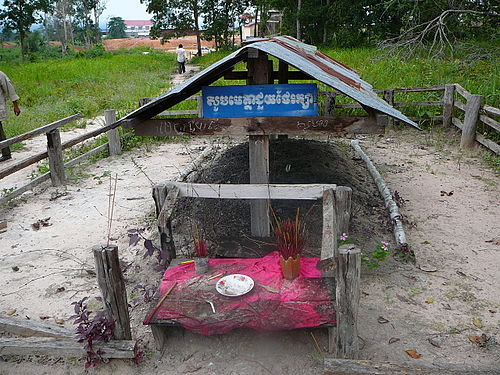Anlong Veng ស្រុកអន្លង់វែង | |
|---|---|
| Coordinates:14°14′N104°05′E / 14.233°N 104.083°E /14.233; 104.083 | |
| Country |  Cambodia Cambodia |
| Province | Oddar Meanchey |
| Population (2018)[1] | |
• Total | 70,000 |
| Time zone | UTC+7 (ICT) |
| Geocode | 2201 |

Anlong Veng (Khmer:អន្លង់វែង,Ânlông Vêng[ɑnluŋʋɛːŋ]) is a district (srok) inOddar Meanchey province inCambodia. The main town in the district is also called Anlong Veng. The population of the district could not be counted during the 1998 census of Cambodia due to ongoing conflict during the time of the census.[2] It is estimated that 35% of the population in Anlong Veng were formerKhmer Rouge soldiers including theMaoist dictatorPol Pot (Saloth Sar).[1]
Anlong Veng is in the area of theDângrêk Mountains, in the far north of Cambodia. It is located 125 km north ofSiem Reap and close to theinternational border crossing withThailand. There is a dam just north of the town.

Anlong Veng is best known for two historical reasons. It was the last stronghold of theKhmer Rouge to come under government control in 1998 and the final resting place of Pol Pot.
The Dângrêk Mountains were used as a base by the Khmer Rouge when they fought against theKhmer Republic led by generalLon Nol.
After the end of theVietnamese occupation of Cambodia and the withdrawal of the Vietnamese army, the Khmer Rouge rebuilt their former bases in the Dangrek mountain range area, along the border of Thailand. Anlong Veng became for a while the main "capital" of the Khmer Rouge. In the 1990s the Khmer Rouge still controlled Anlong Veng, where there was one of the first "Killing Fields" after the fall of "Democratic Kampuchea".
There is a still not excavated site in a forest with landmines in the Dângrêk Mountains, located about 6 km out of Anlong Veng where 3,000 people were allegedly killed by the Khmer Rouge for having become "corrupted" as late as between 1993 and 1997. These executions were carried out duringTa Mok's leadership in the area.[3]
The following table shows the villages of Anlong Veng district by commune.
| Khum (Communes) | Phum (Villages) |
|---|---|
| Anlong Veng | Kaoh Thmei, Ou Chenhchien, Prolean, Yeang Khang Tbong, Thnal Kandal Kraom, Thnal Kandal Leu, Thnal Totueng, Thnal Bambaek, Thnal Kaeng, Akphivoad, Rumchek, Yeang Khang Chheung, Thnal Thmey, Rumchek Khang Kert, Ou Ta Meng, Rumchek Khang Lech |
| Trapeang Tav | Trapeang Tav, Ta Dev, Ou Angrae, Slaeng Por, Tuol Prasat, Tuol Svay, Thmei, Tumnob, Ou SrorMor, Tuol Svay Saen Chey |
| Trapeang Prei | Tuol Kandal, Tuol Sala, Aekakpheap, Boeng, Cheung Phnum, Khleang Kandal, Prasat, Santepheap, Srah Chhuk, Tuol Tbaeng, Tumnob Leu, Tuek Chob, Tuek Chum |
| Thlat | Chheu Teal Chrum, Ou Run, Svay Chek, Thlat, Tuol Kruos, Tuol Kralanh, Tuol Prich, Thmei |
| Lumtong | Lumtong, Treas, Ou Kokir Kandal, Ou Kokir Kraom, Ou Kokir Leu, Lumtong Thmei, Sror LaoSroang, Trapaeng Thom, Chub Ta Mok, Kork Samphor, Char |
Prime-minister Hun Sen'sHistorical Restoration Initiative circular (Dec 2001) called for the site at Anlong Veng to become a memorial and tourist site in time for the Visit Cambodia year in 2003. The town is seen by the government as a useful stopping point for tours from Siem Riep to the 11th-century temples atPreah Vihear. The site has had minor tourist developments including museums, hotels and a casino.